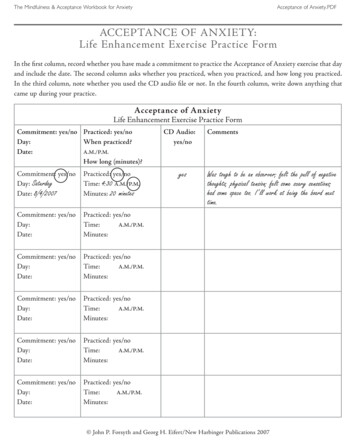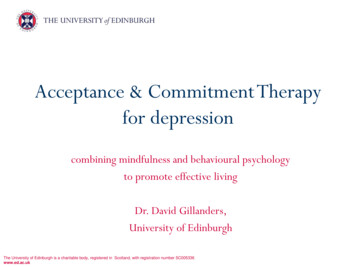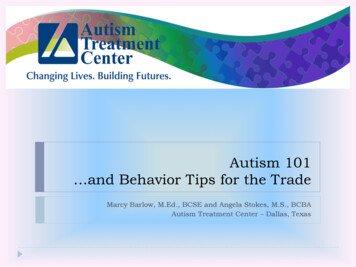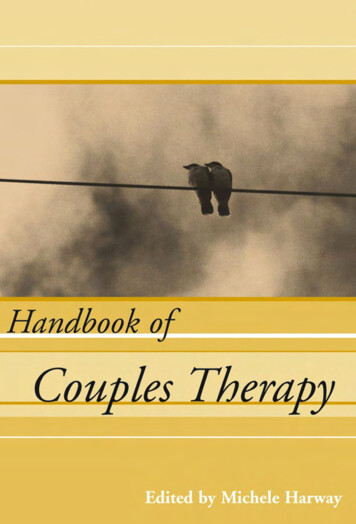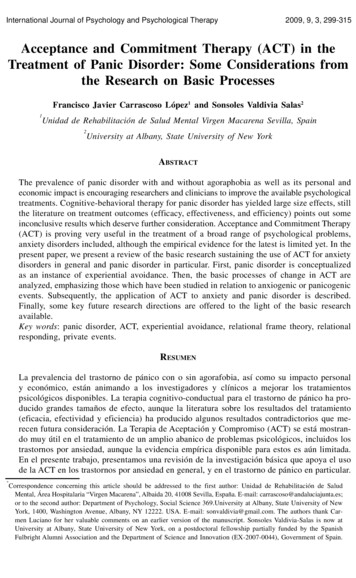
Transcription
International Journal of Psychology and Psychological Therapy2009, 9, 3, 299-315Acceptance and Commitment Therapy (ACT) in theTreatment of Panic Disorder: Some Considerations fromthe Research on Basic ProcessesFrancisco Javier Carrascoso López1 and Sonsoles Valdivia Salas21Unidad de Rehabilitación de Salud Mental Virgen Macarena Sevilla, Spain2University at Albany, State University of New YorkABSTRACTThe prevalence of panic disorder with and without agoraphobia as well as its personal andeconomic impact is encouraging researchers and clinicians to improve the available psychologicaltreatments. Cognitive-behavioral therapy for panic disorder has yielded large size effects, stillthe literature on treatment outcomes (efficacy, effectiveness, and efficiency) points out someinconclusive results which deserve further consideration. Acceptance and Commitment Therapy(ACT) is proving very useful in the treatment of a broad range of psychological problems,anxiety disorders included, although the empirical evidence for the latest is limited yet. In thepresent paper, we present a review of the basic research sustaining the use of ACT for anxietydisorders in general and panic disorder in particular. First, panic disorder is conceptualizedas an instance of experiential avoidance. Then, the basic processes of change in ACT areanalyzed, emphasizing those which have been studied in relation to anxiogenic or panicogenicevents. Subsequently, the application of ACT to anxiety and panic disorder is described.Finally, some key future research directions are offered to the light of the basic researchavailable.Key words: panic disorder, ACT, experiential avoidance, relational frame theory, relationalresponding, private events.RESUMENLa prevalencia del trastorno de pánico con o sin agorafobia, así como su impacto personaly económico, están animando a los investigadores y clínicos a mejorar los tratamientospsicológicos disponibles. La terapia cognitivo-conductual para el trastorno de pánico ha producido grandes tamaños de efecto, aunque la literatura sobre los resultados del tratamiento(eficacia, efectividad y eficiencia) ha producido algunos resultados contradictorios que merecen futura consideración. La Terapia de Aceptación y Compromiso (ACT) se está mostrando muy útil en el tratamiento de un amplio abanico de problemas psicológicos, incluidos lostrastornos por ansiedad, aunque la evidencia empírica disponible para estos es aún limitada.En el presente trabajo, presentamos una revisión de la investigación básica que apoya el usode la ACT en los trastornos por ansiedad en general, y en el trastorno de pánico en particular.*Correspondence concerning this article should be addressed to the first author: Unidad de Rehabilitación de SaludMental, Área Hospitalaria “Virgen Macarena”, Albaida 20, 41008 Sevilla, España. E-mail: carrascoso@andaluciajunta.es;or to the second author: Department of Psychology, Social Science 369.University at Albany, State University of NewYork, 1400, Washington Avenue, Albany, NY 12222. USA. E-mail: sonvaldivia@gmail.com. The authors thank Carmen Luciano for her valuable comments on an earlier version of the manuscript. Sonsoles Valdivia-Salas is now atUniversity at Albany, State University of New York, on a postdoctoral fellowship partially funded by the SpanishFulbright Alumni Association and the Department of Science and Innovation (EX-2007-0044), Government of Spain.
300CARRASCOSO LÓPEZ & VALDIVIA SALASEn primer lugar, el trastorno de pánico es conceptuado como una instancia de evitaciónexperiencial. Posteriormente son analizados los procesos de cambio presupuestos en la ACT,enfatizando aquellos que han sido estudiados en relación a eventos ansiogénicos. Por último,describimos la aplicación de la ACT en los trastornos por ansiedad y en el trastorno porpánico que se deriva de la revisión previa de la literatura de investigación. Finalmente, seofrecen algunas recomendaciones de futuras líneas de investigación a la luz de la literaturade investigación básica disponible.Palabras clave: trastorno de pánico, ACT, evitación experiencial, teoría de los marcosrelacionales, responder relacional, eventos privados.Panic disorder (PD) is traditionally defined by the occurrence of unexpected andintense episodes of fear accompanied by physical and cognitive symptoms (AmericanPsychiatric Association, 1994). Some of the most salient characteristics of PD are: 1)Panic attacks are accompanied by worries about future attacks, the consequences ofattacks, or behavioral changes related to the attacks; and 2) it usually involves theavoidance of situations, behaviors or events that may produce similar somatic symptomsto those experienced during a panic attack. Individuals with PD usually present an earlylearning history in which the potential dangers of physical sensations have beenemphasized. Also, those individuals are most likely to have observed panic symptomsor chronic illnesses in their family members, and to have received parental encouragementfor sick-role behavior during their own experiences of panic-like symptoms (Orsillo,Roemer, Block-Lerner, LeJeune, & Herbert, 2004).The first choice treatments for such disorders are the diverse variations of exposuretechniques and cognitive restructuring (e.g., Barlow, Raffa & Cohen, 2002; Task Forceon Promotion and Dissemination of Psychological Procedures, 1995). As quoted byOrsillo et al. (2004), cognitive-behavioral treatment (CBT) for PD has yielded largeeffect sizes (.68 to .88; Gould, Otto & Pollack, 1995), estimating that between 41% and100% of clients are panic free 12 months following the termination of treatment (Barlow,2002). It is assumed, thus, that treatments for anxiety disorders that retain and enhancethe exposure component are most likely to produce clinically significant and meaningfulresults.Nonetheless, there are a number of gaps in the literature on the efficacy,effectiveness, and efficiency of those treatments. First, between 20% and 30% of theclients who are administered behavior therapy and CBT do not improve. Second, apercentage of clients (between 5% and 15% depending on the source) quit treatmentbefore it is completed. Third, there is little knowledge about the behavioral processesunderlying the changes observed with the application of CBT (Eifert & Forsyth, 2005).These data along with the research on the paradoxical effects of thought suppressionfirst developed by D. M Wegner and colleagues in the 90’s (e.g., Wegner, 1994; Wenzlaff& Wegner, 2000), and extended by several authors at present, motivated researchersand clinicians to explore alternative approaches to therapy. Intern. Jour. Psych. Psychol. Ther.
301ACT AND PANIC DISORDERchange in the contingencies observed in rule-governed behavior, and 3) behavior-behaviorarbitrary relations, was specially considered (Hayes, Strosahl, & Wilson, 1999). Theresult was what has been termed as Third Wave Behavior Therapy (Hayes, 2004), outof which we will focus in the Acceptance and Commitment Therapy as the most complete of the therapies included in this tradition. The three main descriptors of ACTaccording to Hayes, Strosahl, Bunting, Twohig and Wilson (2004) are the following.First, its basic foundations stem from the Relational Frame Theory (RFT; Hayes, BarnesHolmes, & Roche, 2001); second, ACT assumes the basic principles of the FunctionalContextualism (Gifford & Hayes, 1999; Hayes, Strosahl, & Wilson, 1999); and third,it proposes a functional model of psychopathology with the Experiential AvoidanceDisorder as the functional diagnostic dimension present across several diagnostic categoriesincluded in the DSM-IV (Hayes, Wilson, Gifford, Follette & Strosahl, 1996; Luciano& Hayes, 2001). Furthermore, there is a special emphasis in the research on processesof change for the development and improvement of the methods and techniques includedin ACT, as well as in the strictly functional nature of psychopathology and therapy. Thisturns ACT into a flexible conceptual and therapeutic model that may be used withmultiple and varied problems, as it is being noted across several, but all coherent,treatment manuals (e.g., Dahl & Lundgren, 2006; Dahl, Wilson, Luciano, & Hayes,2005; Eifert & Forsyth, 2005; Eifert, McKay, & Forsyth, 2006; Hayes & Strosahl,2004), and empirical studies (Hayes, Masuda, Bissett, Luoma, & Guerrero, 2004 for areview).The purpose of the present paper is to briefly review the basic research sustainingthe model of psychopathology and therapy that ACT embraces. With this goal, we firstpresent panic disorder as an instance of destructive experiential avoidance, followed bythe research on process of change in ACT. Lastly, we will describe some considerationsin relation to the future research on the use of ACT in the treatment of panic disorder.These considerations derive directly from our review of the basic research about changeprocesses in ACT.PANIC DISORDER AS AN INSTANCE OF EXPERIENTIAL AVOIDANCE DISORDERDSM-IV states that one of the main characteristics across anxiety disorders isthe avoidance or escape from the situations or stimuli functions which are likely toelicit anxiety, as well as the deliberate efforts to somehow control such situations (i.e.,safety behaviors). Several authors within ACT perspective (Eifert & Forsyth, 2005;Orsillo, et al., 2004) as well as others within CBT models (Barlow, Allen & Choate,2004) have noticed a functional overlapping among symptoms of diverse subclasseswithin the category anxiety disorders. This is to say that although the symptoms definingeach subcategory look different in terms of topography, they all are maintained by thesame contingencies, i.e., negative reinforcement predominantly. Cognitive and/orphysiological vulnerabilities (e.g., general tendency towards anxious apprehension) havealso been pointed out as common aspects across anxiety disorders (e.g., Barlow, 2002),but these are beyond the scope of the present paper. Intern. Jour. Psych. Psychol. Ther.
302CARRASCOSO LÓPEZ & VALDIVIA SALASExperiential avoidance (EA) occurs when an individual is not willing to stay incontact with a variety of private events which are experienced as aversive (pain, fears,feelings of loneliness, insecurity, anxiety, traumatic memories, etc.) and makes diversedeliberate efforts to alter the form and frequency of those events and the contexts thatoccasion them (Hayes et al., 1996; Luciano & Hayes, 2001). The immediate consequenceof these varied efforts is the momentary relief from the aversive state the individualwas experiencing, which turns into a potent negative reinforcement for avoiding. In thelong run, however, the intensity and frequency of those private events experienced asaversive increase to the point that the individual restricts his life to do whatever it takesto get rid of the suffering, abandoning the valued/meaningful directions in his life.The emergence and pervasiveness of EA has to do with two phenomena; on theone hand the bidirectional nature of language (for a book length review, see Hayes etal., 2001); on the other hand the inappropriate generalization of control rules which issupported culturally with the idea that emotions and cognitions are the causes of behavior(Hayes et al., 1996). The bidirectional nature of language (mutual and combinatorialentailment, and transformation of functions) implies, very briefly, that we learn to reactto words as if the referents the words stand for were present. For instance, if we hearor read the word lemon, given the proper context we may picture a lemon, and evensalivate in the absence of any lemon in our mouth. Likewise, the thought I’ll die maybring all the functions of death, which usually are aversive given the establishment ofdeath in a frame of opposition to life. This way, the thought I’ll die may become byitself extremely aversive, even when the referent -actual death- is not occurring but asa verbal or relational process.Once relational responding (i.e., responding to an event on the basis of therelations that have been established in the personal history between such event andother events not sharing any physical property with the former) has been established asan operant and through multiple examples, approximately at the age of 19 months(Luciano, Gómez, & Rodríguez, 2007), the transformation of functions is automaticand hence, not under the voluntary control of the individual. That is, having memories,thoughts, sensations, images, etc. of a traumatic past experience or of a feared futurewill be unavoidable given certain circumstances. And this should not be a problemunless somebody says otherwise -which is, by the way, what happens. In other words,since thoughts, feelings, private events in general, are not causes of behavior(MacCorquordale & Meehl, 1948), the unavoidable transformation of functions thatoccurs as the individual “walks through” his/her life, should not control the directionof the steps he makes. What truly happens is that the verbal community, through moreor less subtle messages (anxiety does not help; hyperventilation denotes a poor selfcontrol; etc.), and by means of promoting certain ways of speaking (I would do it,but ; I am worthless; there is no way out, etc.), among other, transforms the privateevents into barriers for action. Statement like “hyperventilation denotes a poor selfcontrol,” “palpitations may be dangerous,” “unless you feel confident, do not go out,”etc. frame the panic symptoms in a relation of opposition to life, and to the qualitiesthat are supposed to involve psychological well-being in the mainstream culture (selfcontrol, self-confidence, no worries, no fears, etc.). To the extent that these have acquired Intern. Jour. Psych. Psychol. Ther.
ACT AND PANIC DISORDER303reinforcing functions in the history of the individual, the panic symptoms will acquireaversive functions, thus will become something to get rid of, because of having beenestablished as ‘incompatible to’ or opposite of having a healthy living (Luciano et al.,2006).The maintenance of the rigid pattern of EA is related to four verbal contextpotentiated by the verbal community: Literality, Evaluation, Reasons-giving, and Control of Causes. Literality means fusion with the function, or the referent, of the words.This way, literality occurs when an individual having the thought “one of these daysI will die from a panic attack” behaves according to the literal meaning that has beenestablish for the word die, that is, avoiding the possibility of dying, in this case,avoiding the possibility of having any of the symptoms that define the panic attack forthat individual, which have acquired the same functions than actual dying. Evaluationmeans the tendency to evaluate everything and to get fusioned to the content of theevaluation, for instance, “panic attacks are for crazy people,” “I must by crazy,” “crazyis bad,” “I am bad, worthless,” etc. Reasons-giving means the tendency to establish areason for every single occurrence of any type of event. Especially relevant here, whenthe access to the causes of a particular behavior is limited, then the context of Reasongiving potentiates establishing internal events that correlate with such behavior as itscauses, for instance, he went outside because he was hyperventilating, she will stayhome because her heart is beating too fast, etc. Control of Causes is the tendency toremove what is aversive and to pursue what is reinforcing, which is extremely usefulwhen applied to the events that occur in the external world (if I replace the brokencables, the computer will work again). The problem is when we try to apply the samerules that work for the world outside, to what has been established as the causes of ourbehavior, i.e. to our private events. In the example above, in order to have individualswho do not go outside in the middle of something important, or who attend previouscommitments, we should first replace their anxiety, fears of death and other panicsymptoms. This is the context that makes sense of the others to the extent that themomentary relief experienced by the individuals when they get to ameliorate theirsymptoms (including fears of such symptoms), functions as a potent reinforcer that,indeed, reinforce the whole rationale supporting control efforts (Luciano, Rodríguez, &Gutiérrez, 2004). EA becomes a problem when the inflexible patterns of avoidancerestricts the life of the individuals to the point of abandoning the trajectories that givemeaning or value to their lives according to personal standards.Within this perspective, PD would be a case of rigid verbal regulation controlledby the necessity of getting rid of the symptoms of a panic attack, the fears of thesymptoms of a panic attack, memories, self-attributions, disturbing feelings, etc., priorto engaging in personal valuable trajectories or directions. Depending on the consequencesthat control this type of destructive verbal regulation, PD may be an instance of generalizedpliance -which interferes with the sensitivity to the direct consequences of the action,or overextended tracking -reacting to private events in a way which is not useful to longterm goals, or the type of augmenting which transform private events into barriers foraction and promote the control rules (Hayes, Gifford, & Hayes, 1998; Torneke, Luciano,& Valdivia, 2008). The goal of ACT is then to undermine private events as barriers for Intern. Jour. Psych. Psychol. Ther.
304CARRASCOSO LÓPEZ & VALDIVIA SALASaction and to promote flexibility in the reaction to those private events so as to facilitatethe occurrence of behavior in valued trajectories.PROCESSES OF CHANGE IN ACT AND PDThe behaviors traditionally defining PD with or without agoraphobia might bedivided into three classes according to functional criteria: a) avoidance and escape fromthe own experience of panic (hyperventilation, relaxation, distraction, etc.); b) effortsto control the situations eliciting panic responses (safety behaviors, efforts to suppressthoughts and memories); and c) functional detach from the own personal values. Thesethree functional groups are well described in the FEAR algorithm (Fusion, Evaluation,Avoidance, and Reasons; Hayes, Strosahl, & Wilson, 1999). Applied to PD, the FEARalgorithm depicts a person who is involved in a process of EA characterized by 1)constant evaluation of the physical sensations and situations in which they occur(hyperventilating is bad, dangerous; going out is risky, it will kill me, etc.); 2) literalbehavior with regard to the contents of such evaluations, that is, systematic efforts toavoid, escape and control the feared situations as much as possible (hyperventilatingand going out will make me die, therefore I will stay home); 3) justifying the avoidanceand escape behaviors as well as their results (I cannot go out because otherwise I willdie; with such strong physiological reactions I cannot do anything); 4) deliberate effortsto control panic attacks, which are incompatible with valued living.The therapeutic intervention is aimed at replacing the FEAR functioning, presentin all forms of EA including PD, with the ACT functioning (Accept, Choose, and Takeaction; Hayes, Strosahl, & Wilson, 1999), which is more flexible and adaptive, andallows the person keeping the commitment with his/her personal values. Strosahl, Hayes,Wilson, and Gifford (2004) present a detailed description of the six processes of changethat characterize ACT, concretely, Acceptance, Defusion, Mindfulness, Self as Context,Values, and Committed Action. The empirical research on the six processes of changeis not consolidated yet, but it is developing steadily with promising results. We willpresent a review of the main findings derived from the research on the processes ofchange in ACT. It does not intend to be exhaustive, but to show the evidence thatsupports the use of ACT for the treatment of PD, as well as the coherence of the termexperiential avoidance as a functional diagnostic category. Only some of the six processesof change have been investigated in relation to panicogenic tasks or private events.While such evidence is accumulated, however, we believe that a brief description maybe enlightening. After all, the key is the presence of aversive private experiences to dealwith (yet anxiety, yet fears, yet discomfort, etc.) and not the means by which those arebrought to bear.So far, the process of Acceptance has accumulated vast empirical support acrossa number of experimental studies utilizing clinical populations, and analogue studies.In fact and directly related to anxiety, there is some evidence of the benefits of acceptancevs. control rationales for enhancing the exposure practice among individuals with PD.For instance, Levitt, Brown, Orsillo, and Barlow (2004) exposed three groups of clients Intern. Jour. Psych. Psychol. Ther.
ACT AND PANIC DISORDER305to a CO2 inhalation challenge after being administered either a suppression protocol,or an acceptance protocol, or a control instruction condition. Results showed that althoughthe physiological reactions to the challenge did not differ among conditions, only theclients in the acceptance condition reported less anxiety and agreed to being exposedto a second challenge. Similar results were obtained by Eifert and Heffner (2003) byexposing women scoring high in sensitivity to anxiety as measured with the AAQ toCO2 enriched air inhalation tasks. Worth mentioning, none of the women discontinuedtheir participation before the tasks were completed. Likewise, Spira, Zvolensky, Eifert,and Feldner (2004) showed that control-based coping strategies predicted more readilythan other coping strategies the occurrence of frequent and intense cognitive and physicalsymptoms related to panic. Another source of evidence in the same direction, althoughnot in relation to panicogenic events, is the research on coping with pain (Hayes,Bissett et al, 1999; Gutiérrez, Luciano, Rodríguez, & Fink, 2004; Masedo & Esteve,2007; Páez Blarrina et al., 2008a; 2008b). Very briefly, it has been reported that participantswho are presented with an acceptance-based protocol prior to being exposed to painfulstimulation show higher pain tolerance and less pain believability than those participantsexposed to a cognitive control-based protocol.Within a different tradition, the literature on thought suppression yields evidenceof the harmful effects of coping strategies based on cognitive control. Specifically, ithas been shown the paradoxical effects of thought suppression on the resurgence of thesuppressed thoughts and emotions. For instance, suppression strategies turn the suppressedthoughts into more accessible contents (Wegner & Erber, 1992), relaxation while instress conditions increments stress levels (Wegner, Broome, & Blumberg, 1997), andsuppressed thoughts appear in the dreams (Wegner, Wenzlaff, & Kozak, 2004). Besidescontradictory results, it seems that suppression strategies do not cause the increment inthe frequency of the suppressed contents in a direct way, but by affecting the mood sothat the participants remain more alert to the presence of aversive private events(Abramowitz, Tolin, & Street, 2001; Purdon, Rowa, & Anthony, 2005).Regarding the process of change Defusion, a recent study by Masuda, Hayes,Sackett and Twohig (2004) showed that participants exposed to the milk-milk exerciseas described in the manual by Hayes, Strosahl, & Wilson (1999) showed a reductionof believability and distress produced by negative self-referential thoughts. Also, ValdiviaSalas, Luciano, and Molina (2006) showed that children who were exposed to a protocoldescribing a long walk in a hot desert with no beverages available, and interspersinglanguage games with the words included in the protocol, reported less thirst and drankless water than the children exposed to the same protocol with no language gamesincluded.Same as in the case of Defusion, the evidence of the processes Values andCommitted Action, intimately related to the evidence on Acceptance, has not beenaccumulated by employing panicogenic tasks. Although there is not an operationaldefinition of what it means to behave towards values, research has relied on the conceptual approach to the concept of values and on the clinical significance criterion (i.e.,quality of life) to conduct analogue studies and clinical trials. The research on copingwith pain is important on this regard. Across experimental preparations with methodological Intern. Jour. Psych. Psychol. Ther.
306CARRASCOSO LÓPEZ & VALDIVIA SALASimprovements and refinements, it has been shown that the only presentation of a protocolestablishing the context for continuing in the pain task as a chosen action within avalued direction reduces the believability of pain significantly, what is enhanced withthe subsequent introduction of an acceptance-based coping strategy (Páez Blarrina etal., 2008b). This is the first study that isolates the effect of introducing a value contextfor continuing in a task from other components like defusion.Summing up, the more extensive evidence has been accumulated for Acceptanceand Defusion, while the evidence for Values and Committed Action is very little yet.Nonetheless, to the extent that acting in a valued direction in the presence of pain,discomfort, fear, anxiety and the like, means to accept those experiences as part of thechosen direction, and this necessarily involves defusing and distancing from suchexperiences, in other words, having the experience of self as the context of all thosecontents and processes, or mindfulness, we believe that the evidence so far is quiteimportant. Furthermore, it greatly supports the promotion of those three processes ofchange during the course of therapy. Table 1 shows the six processes of change definedin the literature, and how they match the three behavioral classes defining PD. Asshown in the table, ACT-based interventions should include at least three main goals:1) acceptance of the feared private events; 2) weakening the verbal rationale for theavoidance of the private experience; and 3) promotion and reinforcement of behaviorsin valued directions.ACCEPTANCE AND COMMITMENT THERAPY AS AN ALTERNATIVE APPROACH TO THETREATMENT OF PDWe have noted the effectiveness of exposure techniques for the treatment of PDin a previous section. Nonetheless, clients tend to feel reluctant and avoidant aboutexposure practice because of fear of the target of the exposure. ACT directly addressesthis reluctance “through methods aimed at decreasing fusion, building self as process,contacting self as context, defining valued life directions, and building patterns ofcommitted actions” (Orsillo et al., 2004, p. 105), so that exposure becomes a chosenaction in the direction of a valued direction defined by the client. In line with this, itis affirmed that the acceptance rationale increases the willingness to experience panicsymptoms among the individuals with a diagnostic of PD (Orsillo et al., 2004).For the operational definition of a process of change to be pragmatic and coherentwith a functional perspective, it should specify the abilities to be displayed by thetherapist (Carrascoso López & Valdivia Salas, 2007). The ACT therapist’s competencieshave been already described by Strosahl et al. (2004) in detail. We will do an overviewof the technical behaviors that the therapist should display when dealing with PD as aninstance of EA, in accordance with the evidence accumulated on processes of changeand the authors’ clinical experience. Readers are warned that this is just a genericdescription and only the functional analysis of the presenting problem will allow theselection of the proper methods (Eifert & Forsyth, 2005 for a detailed description of thetreatment protocol with anxiety disorders). Intern. Jour. Psych. Psychol. Ther.
307ACT AND PANIC DISORDERTable 1. Processes of change in ACT.Process1. Acceptance2. Defusion3. Self as contextProcess4. Mindfulness5. Values6. CommittedActionACC E PTANCE AND DISTANCINGBrief definitionLiterally, it means “to take what it’s offered.” It impliesbehaving according t o personal valued directions in thepresence of privat e events which are experienced asaversive.Taking perspective from t he own private events, noticingthem for what they are (thoughts, feelings, memories,etc.), and not as barriers for action.Distinguishi ng between self as content (“it is impossibleto live with pan ic attacks”) and the self as the context forall private contents and processes (“I’m havi ng thethough t that it is impossible to live with panic attacks”).C OMMITMENT AND CHANGEBrief DefinitionBeing i n full contact with the own experience as ithappens in the here and now. Being aware of the self ascontent and t he self as process in the here and now whilethe client acts towards val ues.Identifying t he valued directions that will direct thebehavior of the individual. They will also make sense ofthe contact with aversive private experiences.Behaving i n accordance with personal valued directionsfor the fulfilment of goals coherent with s uch direction s.Overview of ACT applied to Panic DisorderThe heart of ACT applied to PD will be seeing anxiety for what it is, distinguishingthe self from the symptoms of anxiety and panic, and acting in valued directions(Orsillo et al., 2004). Indirect procedures are highly recommended to achieve thesegoals. In order words, metaphors, paradoxes and experiential exercises will constitutethe basic armamentarium of every ACT therapist. As mentioned before, one of the maingoals of ACT is to weaken the rigid and toxic patterns of rule-following wherever itlimits the contact with what the client really values in his/her life. The indirect procedureshas three advantages: 1) they promote a less literal discourse that makes more likelythe contact with the present contingencies in the here and now; 2) they help depict anddisc
Panic attacks are accompanied by worries about future attacks, the consequences of attacks, or behavioral changes related to the attacks; and 2) it usually involves the avoidance of situations, behaviors or events that may produce similar somatic symptoms to those experienced during a panic
